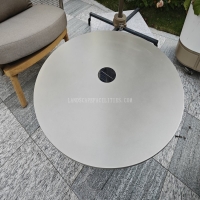Welcome to the website for landscape facilities products and knowledge.
How do landscape bar counters handle spills and stains, especially in outdoor settings?
Outdoor landscape bar counters combine functionality with aesthetic appeal, but they require specific design considerations to handle spills and stains effectively in open-air settings. The key lies in material selection, protective treatments, and practical design features that maintain both beauty and durability against nature's elements.
Premium outdoor bar counters typically utilize non-porous materials that resist liquid penetration. Quartz composites, sealed granite, and stainless steel remain popular choices for their inherent resistance to moisture and staining. These materials prevent liquids from seeping into the surface, allowing for quick cleanup before permanent staining occurs. Many manufacturers now incorporate advanced polymer resins that create impermeable surfaces while mimicking the appearance of natural stone.
Protective sealing represents the first line of defense against stains. High-quality penetrating sealants form an invisible barrier that repels liquids, oils, and UV damage. For natural stone surfaces like granite or concrete, reapplying sealant every 1-2 years maintains optimal protection. Modern nano-technology sealants offer enhanced protection, creating microscopic barriers that prevent even the smallest particles from embedding into the surface.
Design elements significantly contribute to spill management. Subtly sloped surfaces (approximately 1-2 degrees) direct liquids toward discreet drainage channels integrated into the counter design. These channels often lead to concealed collection points or direct drainage away from the structure. Raised edges (about 1/4 inch high) contain spills within designated areas, preventing liquids from dripping onto surrounding surfaces or guests.
Routine maintenance protocols ensure long-term stain resistance. Immediate wiping of spills with mild pH-neutral cleaners prevents setting of stains. For stubborn stains like wine or oil, poultice cleaners drawing stains to the surface prove effective without damaging the sealant. Avoid abrasive cleaners that can compromise protective coatings and create porous areas vulnerable to future staining.
Weather considerations further influence material performance. In humid environments, antimicrobial additives in sealants prevent mold growth in hard-to-reach areas. For sunny locations, UV-resistant coatings prevent fading and maintain structural integrity against thermal expansion. Temperature-resistant materials prevent cracking during freeze-thaw cycles in colder climates.
Advanced materials now incorporate stain-resistant properties directly into their composition. Through-body color porcelain tiles maintain consistent appearance even when chipped, while engineered quartz contains non-porous properties throughout the entire material thickness. Recycled glass composites offer both ecological benefits and exceptional stain resistance due to their naturally non-absorbent characteristics.
Proper installation techniques contribute significantly to spill management. Waterproof underlayment and appropriate joining methods prevent liquid penetration into the underlying structure. Professional installers ensure seamless integration of drainage systems and proper sealing of all edges and connections.
Ultimately, the combination of appropriate materials, professional sealing, intelligent design, and consistent maintenance creates outdoor bar counters that withstand both casual entertaining and nature's challenges while maintaining their aesthetic appeal through years of use.
Related search:

Recommendation
Outdoor stainless steel table with solar-powered ambient lighting feature - excellent design.